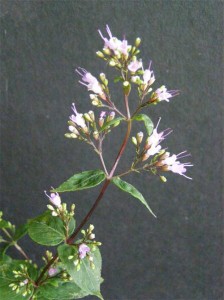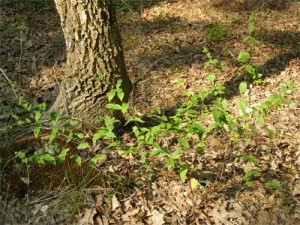Wild oregano

Square-stemmed, opposite-leaved wild oregano flowers more robustly in cultivation than in the wild. Photo by Ken Moore.
By Ken Moore
Don’t go looking for wild oregano, Cunilla origanoides, because you’ll probably become frustrated that you can’t locate it. But you can be aware of it, and then if you do stumble upon it during one of your woods walks it will be a very special moment.
I had such a special moment this past weekend, when exploring the labyrinth of trails of the university’s Carolina North natural area.
My first encounter with this obscure little plant was years ago, while walking through the open chestnut oak forest atop the dome of North Carolina’s Stone Mountain. The forest floor was covered with hundreds of wild oregano plants, which, with the burgundy-colored leaves of the fall, seemed to be a loose carpet beneath the tall oaks. I recall that as one of my memorable “oh, wow†botany experiences.
The few scattered plants along the upper reaches of the Botanical Garden’s nature trails do not make that same lasting impression, nor do the many scattered plants along the trail edges crisscrossing the forested hilltops of Carolina North.
But simply recognizing a few plants here and there is really special for me, and I can’t resist reaching down to gently crush a leaf to enjoy that mild turpentine-scented aroma, so characteristic of this native American herb.
Wild oregano is also known as American dittany, an obvious reference to the dittany of Crete, Origanum dictamnus, which was revered as a magical herb of many medicinal and fantastical properties. Though these plants are kindred spirits within the mint family, our native Cunilla makes no claims such as that magical herb of the ancient Greek isle.
The pleasantly pungent aroma of our wild oregano is definitely engaging. It was utilized by Native Americans throughout its natural range in eastern America for a tea to relieve the discomfort of colds, fevers, headaches and even snakebites.
I concocted a sun tea of a modest bundle of leaves and stems and found the result a pleasing pungent brew that certainly would have been enhanced with a bit of mint or lemon balm. I wonder how a few leaves spread over a homemade pizza would alter the flavor of the anchovies I’m inclined to layer across the surface? I don’t have a sense that this particular native herb has much of a future as a lucrative commercial crop.
Another common name, stone mint, must refer to the typical open rocky forest habitats where we find them scattered throughout our local Piedmont region.

The diminutive wild-oregano, found in dry oak forests, is distinguished by opposite leaves that, when crushed, give a mildly turpentine-mint odor. Photo by Ken Moore.
So that you don’t have to depend on infrequent surprise encounters to appreciate and enjoy wild oregano, I suggest growing a plant or two in a sunny spot in your garden or even in a container. The Botanical Garden has a large container of this wild herb growing just outside the back entrance of the Totten Center. It’s in full flower now and definitely more robust than any plant you will find growing in the dry rocky woods. I procured a nice flowering specimen from the garden and though I’m happy to have a wild oregano of my very own, I will continue to consider it really special to find one in the wild.


Comments are closed.